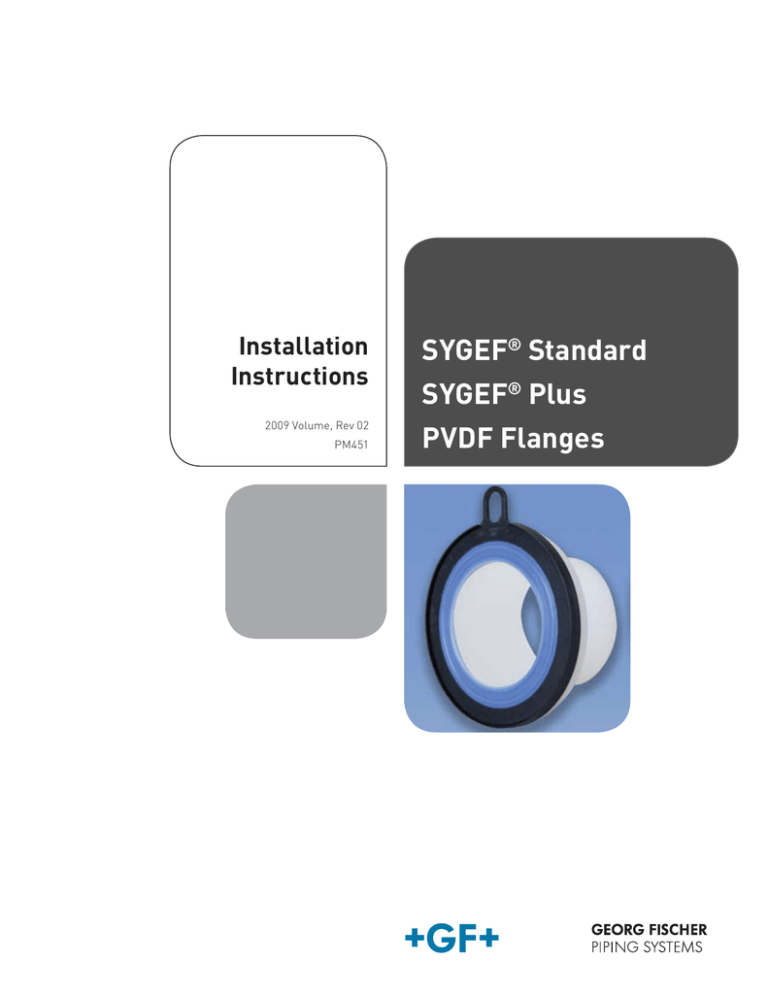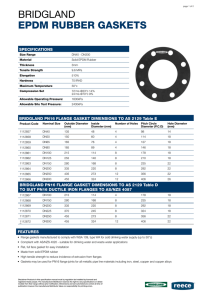SYGEF PVDF Flange Installation Guide
advertisement

Installation Instructions 2009 Volume, Rev 02 PM451 SYGEF® Standard SYGEF® Plus PVDF Flanges Please read all instructions before attempting to install flanges. Introduction When to Use a Flange Flanges may be used when • the piping system may need to be dismantled Materials Polyvinylidenefluoride (PVDF) Flange Adapters Visually inspect flange adapters for cracks, deformities, and other obstructions on the sealing surfaces. Flange Seals • the installation is temporary or mobile A seal must be used between the flange adapter faces in • transitioning between dissimilar materials that can not order to ensure a good seal. The seal can be a flat gasket be cemented together • the installation environment is not conducive to fusion joining or SYGEF Plus gasket for high purity applications. The SYGEF Plus Gasket is the premier solution for Semiconductor UPW and Hot UPW applications. Why Choose a Flange? Manufactured from EPDM rubber with a TFM (modified All SYGEF PVDF flange adapters in combination with gasket combines excellent compression (low torque) with GF flange rings, pipe and fittings, are lightweight, and simple installation (self-centering). easy to install. However, PVDF has different physical properties than metals, and therefore special care is required to ensure that your PVDF flange connections have a long, reliable service life. Installers should study these instructions and follow them carefully in every installation PTFE) covering exposed to the fluid stream, the SYGEF Select the seal material based on the chemical resistance and purity requirements of your system. For applications with maximum 90 PSI (6 bar) working pressure, the flat gaskets can be used. in order to ensure satisfactory performance and enjoy the Full-face gaskets with shore A scale hardness of 70 ±5 full benefits of the GF warranty. should be used. All recommended torque values in tables When using a PVDF flange, ensure that the entire system is well-supported and that the flange does not bear the 4 and 5 are based on this gasket hardness. For other hardness requirements, contact GF Technical Service. weight of a massive, unsupported system component such At increased working and testing pressure, the SYGEF Plus as a cast iron valve. See support instructions in the GF gasket or a profile flange gasket may be required. (Please Technical Manual online: contact GF for design assistance). http://www.gfpiping.com/downloads/engbook/engbook.pdf The SYGEF Plus Gaskets have the following advantages. • TFM (mod. PTFE) coated for high temperature • High purity • Low torque design • Excellent memory, allows multiple installations • Self centering 2 Table 2b ANSI Class 150 ePTFE HP Gasket Dimensions in 12 Size mm 315 in D ANSI mm 15.98 406 in D1 mm 11.80 300 For 12”/315mm, we recommend using an ePTFE HP Gasket with the above dimensions. Thickness 0.12”/3mm. Fasteners Table 1 ANSI Class 150 Flat Flange Gasket Dimensions (Recommended only up to maximum operating pressure of 90 PSI) OD mm should be used. Low-friction materials allow torque to be applied easily and gradually, ensuring that the flange is in ¾ 25 3.88 99 1.06 27 0.12 3 1 32 4.25 108 1.31 33 0.12 3 Either the bolt or the nut, and preferably both, should be 1¼ 40 4.63 118 1.66 42 0.12 3 zinc-plated to ensure minimal friction. If using stainless 1½ 50 5.00 127 1.90 48 0.12 3 2 63 6.00 152 2.38 60 0.12 3 steel bolt and nut, lubricant must be used to prevent high 2½ 75 7.00 178 2.88 73 0.12 3 3 90 7.50 191 3.50 89 0.12 3 4 110 9.00 229 4.50 114 0.12 3 • zinc-on-zinc, with or without lube 6 160 11.00 280 6.63 168 0.12 3 • zinc-on-stainless-steel, with or without lube 8/9 200/225 13.50 343 8.63 219 0.12 3 • stainless-on-stainless, with lube only 10 250 16.00 407 10.75 273 0.12 3 12 315 19.00 483 12.75 324 0.12 3 in Thickness in mm flange. Therefore, only low-friction fastener materials Size mm in ID mm It is critical to avoid excessive compression stress on a 0.375" (9.5) L L1 not subjected to sudden, uneven stress during installation, which can lead to cracking. friction and seizing. In summary, the following fastener combinations are acceptable: No lubricants can be used for high purity applications, only zinc-on-zinc or zinc-on-stainless steel fastener combinations are acceptable. 0.124" (3.4) Cadmium-plated fasteners, while becoming more difficult to obtain due to environmental concerns, are also acceptable with or without lubrication. Galvanized a copper-graphite antiseize lubricant to ensure smooth engagement and the ability to disassemble and reassemble Ø D1 H Ø D ANSI Ø D ISO and carbon-steel fasteners are not recommended. Use the system easily. Bolts must be long enough that two complete threads Table 2a ANSI Class 150 SYGEF Plus Gasket Dimensions in Size mm ¾ 25 in 2.13 D ANSI mm 54 in D1 mm 0.91 23 1 32 2.48 63 1.18 30 1¼ 40 2.87 73 1.50 38 1½ 50 3.23 82 1.81 46 2 63 4.02 102 2.32 59 2½ 75 4.80 122 2.64 67 3 90 5.24 133 3.15 80 4 110 6.22 158 3.86 98 6 160 8.35 212 5.83 148 8/9 200/225 10.55 268 8.23 209 10 250 12.60 320 9.84 250 are exposed when the nut is tightened by hand. Using a longer bolt does not compromise the integrity of the flange connection, although it wastes material and may make tightening more difficult due to interference with nearby system components. 3 Installation Table 3 Steel Flange Fastener Specifications Flange No. of Size (in) Bolts Length1 (in) Washer Bolt Size (in) Size (in) & & Type Type2 Checking System Alignment ¾ 4 2.50 ½-13-UNC ½ SAE of the system being joined are properly aligned. GF has 1 4 3.00 ½-13-UNC ½ SAE 1¼ 4 3.25 ½-13-UNC ½ SAE developed a “pinch test” that allows the installer to assess 1½ 4 3.25 ½-13-UNC ½ SAE 2 4 3.50 5 2½ 4 3.50 5 3 4 4.00 5 4 8 4.00 6 8 4.75 First check the gap between the flange adapter faces by /8 SAE pinching the two mating components toward each other /8 SAE with one hand as shown below. If the faces can be made to 5 /8-11-UNC 5 /8-11-UNC 5 5 /8-11-UNC 5 ¾-10-UNC ¾ F4364 8 and 9 8 5.50 ¾-10-UNC 12 5.25 7 12 12 5.25 7 system alignment quickly and easily with minimal tools. /8 SAE /8-11-UNC 10 Before assembling the flange, be sure that the two parts /8 SAE touch, then the gap between them is acceptable. ¾ F436 /8-9-UNC 7 /8-9-UNC 7 /8 F436 /8 F436 Suggested bolt length for flange-to-flange connection with flat or SYGEF Plus flange gasket. Adjust bolt length as required for other types of connections. Minimum spec. Use of a stronger or thicker washer is always acceptable as long as published torque limits are observed. Also known as Type A Plain Washers, Narrow Series. the faces are completely flush when pinched together, as ASTM F436 required for larger sizes to prevent warping at high torque. continue installation. Otherwise, pinch the faces together 1 2 3 4 A washer must be used under each bolt head and nut. The purpose of the washer is to distribute pressure over a wider area, reducing the compression stress under the bolt head Next check the angle between the flange adapter faces. If shown above, then the alignment is perfect, and you may so that one side is touching, then measure the gap between the faces on the opposite side. The gap should be no more than 1/8”. and nut. Failure to use washers voids the GF warranty. Torque Wrench Compared to metals, plastics are relatively flexible and deform slightly under stress. Therefore, not only must bolt torque be controlled in order to avoid cracking the flange, but continuing to tighten the bolts beyond the recommended torque levels may actually make the seal worse, not better. To assess high-low misalignment, pull the flange faces flush together. If the faces are concentric within 1/8”, then the high-low misalignment is acceptable. Because bolt torque is critical to the proper function of a flange, a current, calibrated torque wrench accurate to within ±1 ft-lb must be used. Experienced installers may be tempted to forgo the use of a torque wrench, relying instead on “feel.” GF does not endorse this practice. Job-site studies have shown that experienced installers are only slightly better than new If the gap between the mating components can not be trainees at estimating bolt torque by feel. A torque wrench closed by pinching them with one hand, or if the angle or is always recommended. high-low misalignment between them is too large, then Never use an impact wrench to install a flange. using the bolts to force the components together will result Refer to Tables 4 and 5 for recommended fastener torque installation. In this case, inspect the system to find the settings. in excessive stress and possible failure during or after greatest source of misalignment and refit the system with proper alignment before bolting. 4 The pinch test is a good rule of thumb, but always use Tighten all nuts by hand. As you tighten each nut, the nuts common sense as well. If it seems difficult or awkward to on the other bolts will loosen slightly. Continue to hand- pull the flange faces together, then stop the installation and tighten all of the nuts until none remain loose. Now the either refit the system or consult your GF representative flange assembly will remain in place as you prepare to fully before proceeding. tighten it. Bolt Hole Alignment Again, when hand-tightened, at least two threads beyond Orientation of bolts should be outside of main axis. Horizontal pipelines should have the shown orientation of the bolts. This will avoid medium drops on the bolts in case the nut should be exposed in order to ensure permanent engagement. If less than two threads are exposed, disassemble the flange and use longer bolts. of a leak. To align the bolt holes of a fixed flange, use standard twoholing procedure. Tightening the Bolts Plastic flanges require gradual, even bolt tightening. Tightening one bolt to the maximum recommended torque while other bolts are only hand-tight, or tightening bolts in the wrong order, produces uneven stresses that may result in cracking or poor sealing. To ensure even distribution of stresses in the fully-installed flange, tighten the bolts in a star pattern as described in Placing the Gasket ANSI B16.5: Center the gasket between the flange adapter faces, with the bolt holes at the outer edge of the gasket. A gasket cut to the specified dimensions (see Tables 1 and 2) should come just to the inner edge of the flange adapter face near the flow path, or overlap the edge slightly. Inserting the Bolts If using copper-graphite antiseize lubricant as recommended, apply the lubricant evenly with a brush directly to the bolt threads, and to the nut if desired. Cover the bolt from its tip to the maximum extent to which the nut The torque required on each bolt in order to achieve will be threaded. No lubricants can be used for high purity the best seal with minimal mechanical stress has been applications, only zinc-on-zinc or zinc-on-stainless steel carefully studied in laboratory and field installations, and is fastener combinations are acceptable. given in Tables 4 and 5. Insert bolts through washers and bolts holes as shown: To ensure even distribution of stresses and a uniform seal, tighten the bolts to the first torque value in the sequence, using a star pattern, then repeat the star pattern while tightening to the next torque value, and so on up to the maximum torque value. A final tightening after 24 hours is recommended, when practical, to ensure that any bolts that have loosened due to relaxation of the polymer are fully engaged. 5 If a flange leaks when pressure-tested, retighten the bolts Note that the torques listed in Tables 4 and 5 are for flange to the full recommended torque and retest. Do not exceed adapter to flange adapter connections. For other types the recommended torque before consulting an engineer or of connections, such as between a flange and a butterfly GF representative. valve, where the full face of the flange is not in contact with Table 4 Flat Gasket Multiple-Pass Bolt Torque the mating component, less torque will be required. Do not apply the maximum listed torque to the bolts in such connections, which may cause deformation or cracking, (Values based on a 70 ± 5 Shore A hardness) Torque Sequence (ft-lb, lubed*) 2nd 3rd 4th 1st Torque Sequence (ft-lb, unlubed**) 1st 2nd 3rd 4th since the flange is not fully supported by the mating ½ 5 10 - - 8 15 - - ¾ 5 10 - - 8 15 - - make the system leak-free after pressure testing. 1 5 10 - - 8 15 - - 1¼ 5 10 - - 8 15 - - 1½ 5 10 - - 8 15 - - 2 5 15 25 - 8 15 30 - 2½ 8 15 32 - 8 15 38 - Provide a copy of these instructions to every installer on 3 10 30 35 - 10 30 40 - 4 8 15 25 - 8 15 30 - the job site prior to beginning installation. Installers who 6 10 20 35 45 20 30 40 50 8 20 30 40 50 20 30 40 55 10 20 30 45 50 20 30 45 60 12 15 30 50 66 20 45 60 75 Size (in) Table 5 SYGEF Plus Gasket Multiple-Pass Bolt Torque (Values based on a 70 ± 5 Shore A hardness) Size Torque Sequence (ft-lb, unlubed**) 2nd 3rd 4th 6 of the listed maximum torque and increase as necessary to Documentation Keep Instructions Available have worked primarily with metal flanges often make critical mistakes when installing PVDF flanges. Even experienced installers will benefit from a quick review of good installation practices before starting a new job. Installation Tags Best practices include tagging each flange with • installer’s initials • installation date • final torque value (e.g., “29.2-31.5”) inch mm 1st ¾ 25 5 10 – – • confirmation of 24-hour torque check (“y” or “n”) 1 32 6 13 – – 1¼ 40 8 16 – – This information can be recorded on pre-printed stickers, 1½ 50 8 19 – – 2 63 10 23 – – 2½ 75 10 25 – – 3 90 10 20 30 – 4 110 10 19 – – 6 160 10 20 36 – 8/9 200/225 10 20 35 48 10 250 10 20 35 46 12 315 15 30 50 73 * Assumes the use of SS, zinc- or cadmium-plated bolt and/or nut along with copper-graphite antiseize lubricant brushed directly onto the bolt threads. ** Assumes the use of zinc- or cadmium-plated bolt, nut, or both. Never use unlubricated, uncoated bolts and nuts with flanges, as high friction and seizing lead to unpredictable torque and a high incidence of cracking and poor sealing. component. Instead, start with approximately two-thirds as shown below, and placed on each flange immediately after installation. Experience has shown that installation tags speed up the process of resolving system leaks and product failures, improve communication between the contractor and distributor or manufacturer, highlight training opportunities, and promote worker diligence. Common Questions and Concerns Q: Will my warranty be voided if these instructions are not followed precisely? A: Not necessarily. We recognize that not every installation Q: Is it possible to tell if a flange was installed incorrectly? A: Yes, usually. Bolt torque is easy to verify with a torque wrench, and excessive force, rough handling, or use occurs under perfect conditions, and our flanges are of non-specified components are often apparent from designed to withstand reasonable variations in operating marks, indentations, discoloration, the microscopic conditions and stress. If there is any doubt about the appearance of cracks, etc. When in doubt, your GF cause of a failure, contact your GF representative. We’ll representative can put you in touch with a factory expert work with you to find a solution. who can help determine whether a flange has been Q: What if the specified materials aren’t available? A: We perform our testing with the most commonly available bolts, lubricants, and gasket materials whenever possible. If you must use a material or installed correctly. Q: I installed a flange as instructed, and it still leaks. Do I have to replace the flange? A: First you should loosen and inspect the flange. Make component not mentioned in these instructions, sure there are no cracks, the gasket is in good condition, call your GF representative to ask about acceptable the bolts are well-lubricated (if applicable) and the substitutions. system is properly aligned. Then reassemble the flange Q: Can I purchase installation materials from GF? A: We offer the SYGEF Plus gaskets, which are designed for our PVDF flange adapters. GF does not offer bolts and lubricants. However, we will gladly review the materials you intend to use prior to installation. Item #M306PVDF (10/09) © Georg Fischer LLC 2009 according to these instructions and test the system again. If you still have a problem, contact your GF representative for help.

